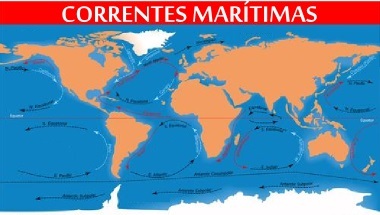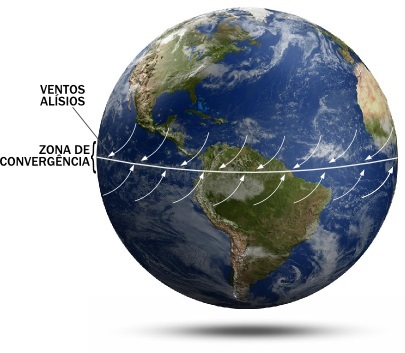At Ocean currents they are sea and ocean water movements with common characteristics in terms of composition and temperature. Their existence, in addition to being fundamental for the existence of numerous species and, consequently, for ecosystems, it is also important for determining climates and the distribution of heat across the planet.
Due to the existence of the coriolis effect - a pseudo force caused by the inertia on bodies that find themselves in rotation, like the Earth – the movement of ocean currents occurs in a Circular. However, because of this same effect, the direction is in different directions depending on the hemisphere: in the north, they move clockwise and in the south, counterclockwise.
To get a general idea of how sea currents move, we can see the schematic map below:

Schematic map with the main large-scale sea currents on the planet
This configuration presented by the map is important to define a part of the climate balance of the planet. The natural conditions of these currents contribute to define the composition of air masses in nearby environments, as well as the meteorological conditions of the destination regions of these masses.
We know that the planet's climate is basically regulated by solar activity, so the influence of ocean currents on the climate is only a derivation of this configuration. In this sense, the oceans receive heat from solar radiation - which occurs at different intensities according to latitudes – and distribute this heat as its waters move. However, it is wrong to think that this distribution is total and compensates for the thermal differences between different parts of the globe.
The temperature of marine currents is relevant to the point of being used to classify them. Therefore, this factor divides the currents into cold and hot. To understand this division, it is necessary to keep in mind that, in terms of radiation and temperature, the zones equatorial areas (low latitudes) are always warmer than polar and extratropical areas (high latitudes).
At cold currents are those that arise from the polar areas, where solar radiation falls less intensely throughout the year and, therefore, generates lower temperatures. Because they are cooler, these currents are denser and circulate at greater depths, in addition to moving more slowly towards the equator.
Do not stop now... There's more after the advertising ;)
The low temperatures of cold currents cause its waters to evaporate in smaller amounts and, therefore, generate less moisture for the environment around them. Due to this configuration, the continental areas that are close to these currents do not receive humid air masses, which provides the existence of more arid climates. An example is the action of Humboldt current in the Pacific Ocean over the western portion of South America that is responsible for the existence of the Atacama Desert, in Chile.
At hot currents, on the other hand, appear in equatorial areas, where solar radiation is more intense throughout the year, which makes their temperatures higher. Consequently, the density of these waters is lower, their displacement is less deep and fast, and their evaporation rate is high, which generates hot and humid air masses for several areas of the planet.
An example of a warm current is found in the Atlantic, the so-called Brazilian current, which is responsible for the humidity that generates much of the rain in the eastern portion of our country. According to some studies, it was this hot and humid climate caused by this sea current that provided the ideal natural conditions for the constitution and maintenance of the Atlantic Forest. Another case is the gulf stream, which causes interference in the climates of North America and Europe.
Therefore, as we can see, the understanding of maritime currents and their effects is of fundamental importance, as, in addition to determining the displacement of marine species and favoring fishing activity in many countries (such as Peru and Japan), they are also important Climatic factors. Even the El Niño it has relationships with these ocean currents, since its formation is in the warming of the waters of the Pacific due to the containment of the Humbolt Current by the trade winds. This and other natural dynamics make us realize how dynamic and interesting our planet is!
By Me. Rodolfo Alves Pena
Would you like to reference this text in a school or academic work? Look:
PENA, Rodolfo F. Alves. "Influence of marine currents on climate"; Brazil School. Available in: https://brasilescola.uol.com.br/geografia/influencia-das-correntes-maritimas-no-clima.htm. Accessed on June 27, 2021.


